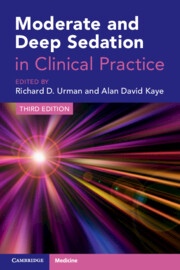Book contents
- Moderate and Deep Sedation in Clinical Practice
- Moderate and Deep Sedation in Clinical Practice
- Copyright page
- Epigraph
- Contents
- Contributors
- Preface
- Chapter 1 Introduction to Moderate and Deep Sedation
- Chapter 2 Pharmacology Principles in Sedation
- Chapter 3 Pain Assessment and Management Considerations
- Chapter 4 Patient Evaluation and Procedure Selection
- Chapter 5 Patient Monitoring, Equipment, and Intravenous Fluids
- Chapter 6 Credentialing, Competency, and Education
- Chapter 7 Quality, Legal, and Risk Management Considerations: Ensuring Program Excellence
- Chapter 8 Nursing Considerations for Sedation
- Chapter 9 Physician Assistants and Nurse Practitioners
- Chapter 10 High-risk Patients: Sedation Considerations in Coexisting Disease
- Chapter 11 Respiratory Compromise in Moderate and Deep Sedation
- Chapter 12 Management of Complications of Moderate and Deep Sedation
- Chapter 13 Recovery and Discharge After Monitored Anesthesia Care
- Chapter 14 Outcomes, Controversies, and Future Trends
- Chapter 15 Simulation Training for Sedation
- Chapter 16 Sedation in the Interventional Radiology Suite
- Chapter 17 Sedation in Endoscopy
- Chapter 18 Sedation in the Interventional Cardiology Suite
- Chapter 19 Sedation and Anesthesia for Interventional Pulmonary Procedures
- Chapter 20 Sedation for Ophthalmological Procedures
- Chapter 21 Procedural Sedation in the Emergency Department
- Chapter 22 Sedation in the Intensive Care Setting
- Chapter 23 Pediatric Sedation: Practical Considerations
- Chapter 24 Safety and Outcomes in Pediatric Sedation
- Chapter 25 Sedation in the Office and Other Outpatient Settings
- Chapter 26 Sedation in Dentistry
- Chapter 27 Sedation for Assisted Reproductive Technologies
- Chapter 28 Interventional Pain Management Procedures
- Chapter 29 Emergency Resuscitation Algorithms: Adults
- Chapter 30 Emergency Resuscitation Algorithms: Infants and Children
- Guidelines and Standards
- Index
- References
Chapter 17 - Sedation in Endoscopy
Published online by Cambridge University Press: 12 December 2024
- Moderate and Deep Sedation in Clinical Practice
- Moderate and Deep Sedation in Clinical Practice
- Copyright page
- Epigraph
- Contents
- Contributors
- Preface
- Chapter 1 Introduction to Moderate and Deep Sedation
- Chapter 2 Pharmacology Principles in Sedation
- Chapter 3 Pain Assessment and Management Considerations
- Chapter 4 Patient Evaluation and Procedure Selection
- Chapter 5 Patient Monitoring, Equipment, and Intravenous Fluids
- Chapter 6 Credentialing, Competency, and Education
- Chapter 7 Quality, Legal, and Risk Management Considerations: Ensuring Program Excellence
- Chapter 8 Nursing Considerations for Sedation
- Chapter 9 Physician Assistants and Nurse Practitioners
- Chapter 10 High-risk Patients: Sedation Considerations in Coexisting Disease
- Chapter 11 Respiratory Compromise in Moderate and Deep Sedation
- Chapter 12 Management of Complications of Moderate and Deep Sedation
- Chapter 13 Recovery and Discharge After Monitored Anesthesia Care
- Chapter 14 Outcomes, Controversies, and Future Trends
- Chapter 15 Simulation Training for Sedation
- Chapter 16 Sedation in the Interventional Radiology Suite
- Chapter 17 Sedation in Endoscopy
- Chapter 18 Sedation in the Interventional Cardiology Suite
- Chapter 19 Sedation and Anesthesia for Interventional Pulmonary Procedures
- Chapter 20 Sedation for Ophthalmological Procedures
- Chapter 21 Procedural Sedation in the Emergency Department
- Chapter 22 Sedation in the Intensive Care Setting
- Chapter 23 Pediatric Sedation: Practical Considerations
- Chapter 24 Safety and Outcomes in Pediatric Sedation
- Chapter 25 Sedation in the Office and Other Outpatient Settings
- Chapter 26 Sedation in Dentistry
- Chapter 27 Sedation for Assisted Reproductive Technologies
- Chapter 28 Interventional Pain Management Procedures
- Chapter 29 Emergency Resuscitation Algorithms: Adults
- Chapter 30 Emergency Resuscitation Algorithms: Infants and Children
- Guidelines and Standards
- Index
- References
Summary
With the technological advancement in medicine, a paradigm shift has been noted in what can be achieved with the minimally invasive endoscopic procedures with equal, and in some cases superior, outcomes as the conventional modalities due to lower procedure and recovery time and markedly reduced adverse outcomes. Approximately 50 million gastrointestinal endoscopic procedures were performed in 2017. Of these, over 19 million were lower gastrointestinal endoscopies (sigmoidoscopies and colonoscopies) [1, 2], and most of these procedures were performed under varying levels of sedation. The advancement in the endoscopic sedation has been equally tremendous, from the unsedated procedures early on, to over 98% of endoscopies being performed under sedation in the United States, with similar trends elsewhere in the world [3]. The most notable change over the last couple of decades has been the shift from hospital to office-based practices and the slow but growing use of sedatives like propofol by non-anesthesiologists despite the ongoing debate on who the appropriate provider for this administration should be [4]. Even though some procedures can be performed unsedated, it is recommended that sedation should be offered to every patient before endoscopy [5], especially since patient satisfaction, in addition to other factors affected by adequate sedation, is considered a quality indicator of endoscopy [3, 6]. As a result, sedation and analgesia are now an integral part of the practice of gastrointestinal endoscopy.
- Type
- Chapter
- Information
- Moderate and Deep Sedation in Clinical Practice , pp. 217 - 234Publisher: Cambridge University PressPrint publication year: 2024

